The dental sector is changing significantly due to growing patient expectations and rapid developments in health technology. Digital diagnostics, regenerative therapies, tailored care models, dental implants, and orthodontics are some of the major trends gaining traction in 2025. At the same time, patient engagement and clinical workflows are improving with cosmetic improvements, eco-friendly procedures, and remote treatment options like teledentistry.
By embracing this wave of innovation, dental professionals are able to enhance the care experience, increase operational efficiency, and improve outcomes. Consequently, the size of the global dental market is expected to increase at a compound annual growth rate (CAGR) of 11.5%, from USD 41.03 billion in 2025 to USD 87.65 billion by 2032.
What are the Top 10 Dental Industry Trends in 2025?
- Dental Implants and Orthodontics
- Personalized Dental Care
- Regenerative and Therapeutic Dentistry
- Cosmetic Dentistry
- Dental Diagnostics
- Sustainable Dentistry
- Oral Hygiene Products
- Laser Dentistry
- Teledentistry
- 3D Printing
Methodology: How We Created the Dental Industry Trend Report
For our trend reports, we leverage our proprietary StartUs Insights Discovery Platform, covering 7M+ global startups, 20K technologies & trends, plus 150M+ patents, news articles, and market reports.
Creating a report involves approximately 40 hours of analysis. We evaluate our own startup data and complement these insights with external research, including industry reports, news articles, and market analyses. This process enables us to identify the most impactful and innovative trends in the dental industry.
For each trend, we select two exemplary startups that meet the following criteria:
- Relevance: Their product, technology, or solution aligns with the trend.
- Founding Year: Established between 2020 and 2025.
- Company Size: A maximum of 200 employees.
- Location: Specific geographic considerations.
This approach ensures our reports provide reliable, actionable insights into the dental industry innovation ecosystem while highlighting startups driving technological advancements in the industry.
Innovation Map outlines the Top 10 Trends in the Dental Industry & 20 Promising Startups
For this in-depth research on the Top Startups & Trends in Dentistry, we analyzed a sample of 3523 global startups & scaleups. The Dentistry Innovation Map, created from this data-driven research, helps you improve strategic decision-making by giving you a comprehensive overview of the dental industry trends & startups that impact your company.
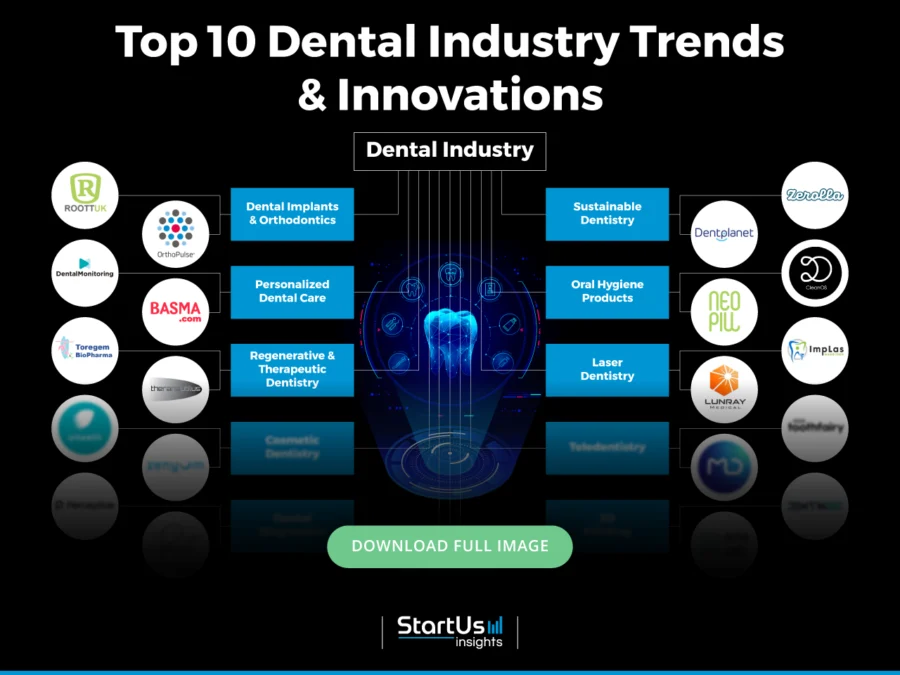
Tree Map reveals the Impact of the Top 10 Dental Technology Trends
The Top 10 Innovations and Trends impacting Dentistry in 2025 are highlighted in the Dental Industry Tree Map. Well-established companies and up-and-coming startups are improving the way dental services are provided and experienced, from dental implants and customized treatment to teledentistry and 3D printing.
In addition to highlighting the growing significance of sustainability, innovative oral hygiene practices, and laser-based procedures, the map highlights significant advances in cosmetic dentistry, diagnostic technology, as well as regenerative and therapeutic therapies. Collectively, these patterns show how the dental sector is adopting eco-friendly, accessible, and precise procedures to improve patient outcomes.
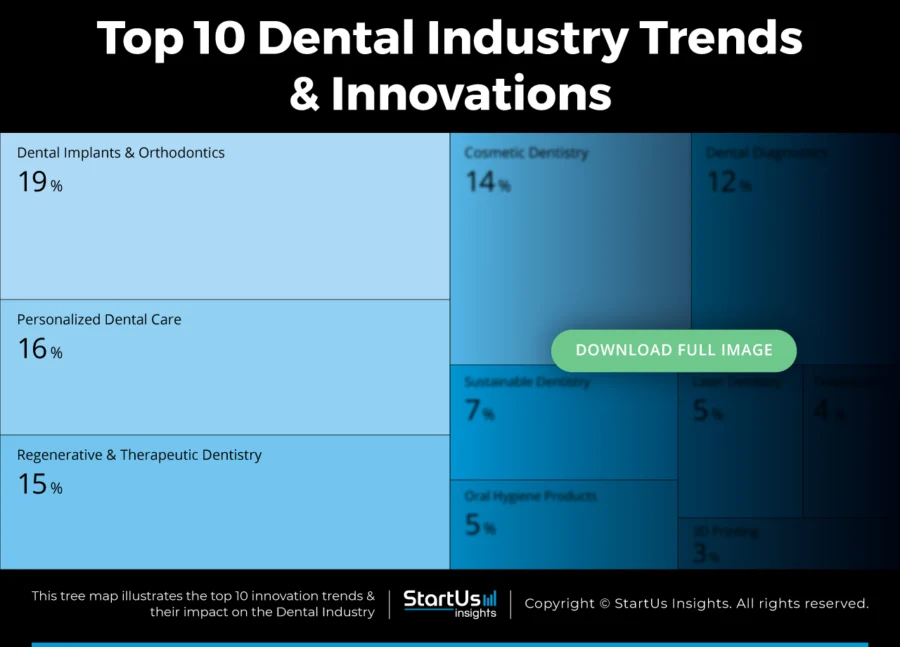
Global Startup Heat Map covers 3523 Dental Startups & Scaleups
The Global Startup Heat Map showcases the distribution of 3523 exemplary startups and scaleups analyzed using the StartUs Insights Discovery Platform. It highlights high startup activity in the US and India, followed by the UK and Canada. From these, 20 promising startups are featured below, selected based on factors like founding year, location, and funding.
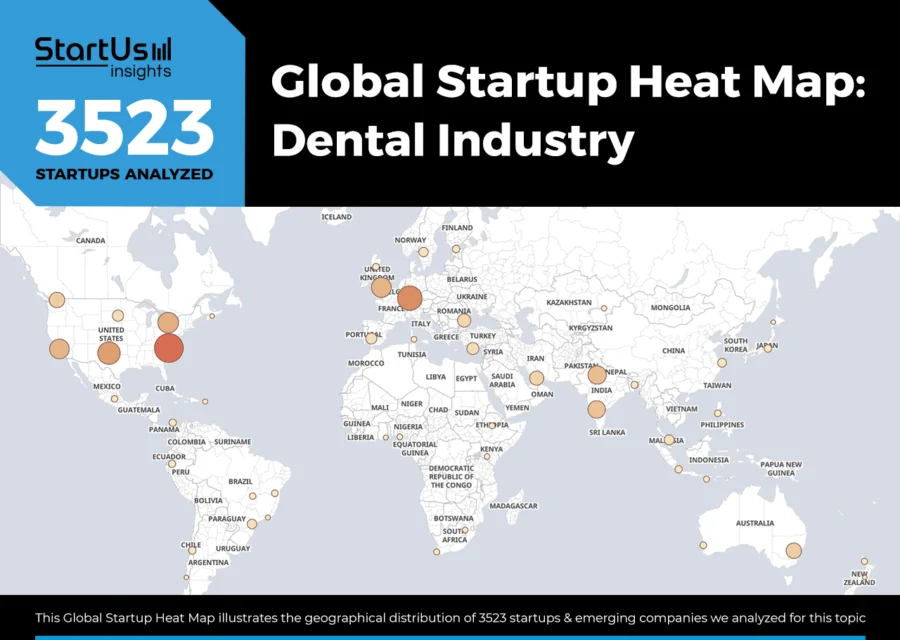
Want to Explore Dental Industry Innovations & Trends?
Top 10 Emerging Dental Industry Trends & Innovations [2025 and Beyond]
1. Dental Implants and Orthodontics
Oral function and self-confidence are impacted by tooth loss, malocclusion, and untreated misalignment, particularly in older individuals and underprivileged adults. Orthodontics and dental implants are emerging as essential answers to these problems. They offer minimally invasive, long-lasting substitutes for braces and conventional restorations.
The global dental implants market is expected to expand at a CAGR of 6.9%, from USD 5.11 billion in 2025 to USD 8.17 billion by 2032, according to Fortune Business Insights. This progress is being driven by improved awareness, insurance coverage, and clinical success rates.
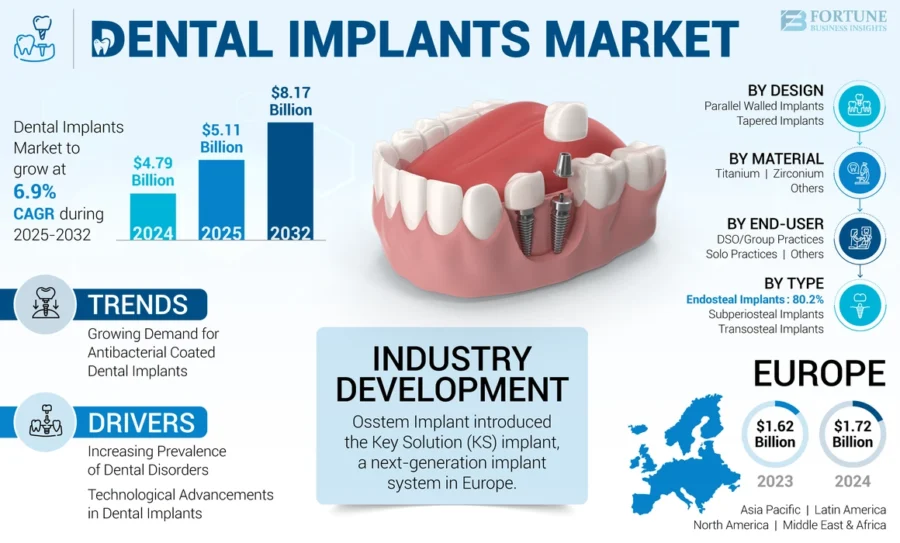
Source: Fortune Business Insights
Many patients find that fixed bridges and dentures are neither comfortable, stable, nor aesthetically pleasing. These days, zirconia or surface-coated titanium implants provide better osseointegration and longer-lasting results. Straumann reported a spike in implant demand in 2025 as a result of China’s development of its dental care policy.
With its TiUltra and Xeal surfaces, Nobel Biocare is at the forefront. For patients with restricted bone volume, Dentsply Sirona has expanded its EV Implant System to include smaller and shorter fixtures. Additionally, BioHorizons is making progress with Laser-Lok microchannels to support long-term crestal bone preservation and soft tissue attachment.
At the same time, concerns about time, money, and visibility frequently prevent orthodontic issues from being treated. That is rapidly changing. The clear aligner market is expected to increase at a CAGR of 31.3% – reaching USD 32.35 billion by 2030.
Bracket systems are also made of metals and ceramics to provide lighter archwires for more comfort, lower-profile designs, and more effective force distribution. For instance, Ormco has improved its self-ligating Damon Ultima bracket system by improving torque control and cutting down on treatment time.
To combine strength and aesthetic discretion, 3M has extended its Clarity Ultra range of translucent ceramic brackets. With sophisticated stainless-steel archwire systems and customized bands for complicated patients, American Orthodontics also keeps innovating.
ROOTT provides Advanced Dental Implants
ROOTT is a UK-based startup that develops a dental implant system with quick installation, full-arch restoration, and narrow ridge circumstances. It provides a modular selection of two-piece and monocomponent implants made for bone and tissue-level applications.
The system uses platform-switching designs, polished transgingival necks, and self-tapping threads to improve soft tissue preservation, minimize marginal bone loss, and increase primary stability.
Each implant integrates with a prosthetic suite that features angulated and multi-unit abutments. This enables efficient chairside workflows and flexible treatment planning. Additionally, the company provides implants with various diameters and lengths to support the anterior and posterior zones.
OrthoPulse enables Infrared Light-Based Orthodontics
Austrian startup OrthoPulse offers an infrared light-based orthodontic device that improves tooth movement during clear aligner or fixed appliance treatment.
The device utilizes low levels of near-infrared light (850 nm wavelength) to stimulate the surrounding alveolar bone and periodontal tissues. This enhances cellular activity and increases bone remodeling.
Additionally, the device features a flexible, mouthguard-style design that provides uniform light energy across both arches. By integrating photobiomodulation therapy into daily treatment routines, the company reduces overall treatment duration and supports predictable tooth movement.
2. Personalized Dental Care
One-size-fits-all dental care is becoming outdated due to growing patient expectations and advancements in clinical technology. To enhance treatment results and patient satisfaction, personalized dentistry care emphasizes individual anatomical, medical, and lifestyle aspects.
The transition to personalized care tackles long-standing problems in traditional therapy. Typical treatment regimens frequently ignore variations in biting forces, jaw form, or oral sensitivity, which result in discomfort, difficulties, or recurrence.
Oral health monitoring platforms allow for continuous, personalized tracking of oral health measures. Grin, for instance, allows patients to record guided intraoral videos from home using a unique smartphone mouthpiece. Dental practitioners then review the videos using a web-based dashboard to track hygiene and treatment progress.
Such platforms make it easier to identify problems early, reduce the frequency of in-office visits, and offer patients the tools they need to actively manage oral health.
Additionally, precision hardware and computerized orthodontics have greatly improved personalized brace planning. LightForce Orthodontics is creating ceramic braces that are 3D printed and tailored to the unique shape of each tooth. This customized method enhances patient comfort, speeds up therapy, and improves bracket alignment.
Indirect bonding trays and unique orthodontic appliance designs are also supported by CAD/CAM systems from manufacturers such as Planmeca and Specialty Appliances. They allow for quick, highly customized bracket installation.
The choice of materials has grown more personal. Clinicians may accurately match restorations to a patient’s enamel characteristics with high-performance ceramics, like GC’s Cerasmart and Ivoclars IPS e.max. They are available in various translucencies and tints. Chairside milling units use these materials since they are both aesthetically pleasing and strong enough to sustain customized restorations the same day.
DentalMonitoring develops an Oral Health Monitoring Platform
French startup DentalMonitoring builds an AI-powered oral health monitoring platform that enables remote, real-time orthodontic and dental treatment assessments. It uses intraoral images taken by patients using its companion smartphone app, which guides consistent image capture.
The platform combines computer vision and machine learning algorithms to process these images and detect intraoral conditions. It also tracks tooth movement and monitors treatment progress.
Further, the platform generates automated clinical reports and alerts practitioners on issues like poor hygiene or broken appliances. It integrates with practice management tools and allows clinicians to streamline follow-ups and reduce unnecessary in-person appointments.
BASMA facilitates Personalized Brace Planning
UAE-based startup BASMA provides a personalized brace planning platform that automates orthodontic workflows. It utilizes intraoral scans, 3D treatment simulation, and remote patient monitoring.
The platform collects digital impressions captured via at-home mold kits or intraoral scanners at partner clinics. Orthodontists then use it to create a staged tooth movement plan using proprietary software.
Further, the startup makes sequential clear aligners in-house and ships them directly to patients. Its companion app also provides wear-time reminders, visual progress simulations, and asynchronous virtual reviews with orthodontists.
3. Regenerative and Therapeutic Dentistry
In response to the increased need for minimally invasive, long-lasting therapies, dentists are increasingly using the body’s inherent ability to heal tissues instead of filling, drilling, or extracting.
The market for therapeutic dental equipment is expected to develop at a CAGR of 8.7% to reach USD 3.45 billion by 2029, propelled by advances in patient-centric technologies and trends in preventative dentistry.

Source: The Business Research Company
Similarly, the market for regenerative dentistry is anticipated to reach USD 5.3 billion by 2034, expanding at a CAGR of 5.4% due to the increased demand for tissue-engineered and biologically based treatments.
Medications that promote tooth growth are the most recent developments. Japanese scientists at Kyoto University and Kitano Hospital finished phase I trials of a medication in 2024 that stimulates the USAG-1 gene to produce new teeth. It may potentially treat injury-related loss and congenital tooth agenesis.
Additionally, dental pulp regeneration is progressing. Researchers at the Harvard School of Dental Medicine have developed stem cell-laden scaffolds that regenerate dentin and pulp, taking the place of root canal therapy. Patients are also able to bank dental stem cells for potential therapeutic use with companies like StemSave.
Further, Geistlich Pharma’s Emdogain aids in periodontal regeneration by repairing the hard and soft tissue surrounding teeth using enamel matrix proteins. By releasing bioavailable calcium and phosphate, remineralization treatments, like NovaMin (in Sensodyne Repair & Protect), aid in enamel restoration.
Nanorobotics is also a developing field to watch in the future. Magnetically directed nanobots have been shown by researchers at the Indian Institute of Science to deep-clean infected root canals. This ensures highly focused, non-invasive therapeutic alternatives to conventional endodontic equipment.
Tregem Biopharma formulates Teeth Regrowth Drugs
Japanese startup Tregem Biopharma develops a teeth regrowth drug that targets congenital tooth agenesis and acquired tooth loss. The company engineers a humanized monoclonal antibody that inhibits USAG-1, a protein known to suppress BMP signaling pathways essential for tooth development.
By blocking USAG-1, the drug reactivates odontogenic potential in the dental lamina to enable the formation of a third dentition in animal models. The therapy also focuses on pediatric and adult patients with partial anodontia or tooth loss due to trauma or disease.
This approach aims to regenerate fully functional permanent teeth without implants. Preclinical studies further demonstrate controlled eruption, natural alignment, and root development.
Theranautilus advances Nanorobotics for Dental Therapy
Indian company Theranautilus builds nanorobotic systems for targeted dental therapy. It deploys magnetically guided helical nanobots to access and disinfect complex anatomical sites within the root canal.
The company fabricates these nanobots from silica-coated iron oxide. The bots rotate and navigate through dentinal tubules with the actuation of external magnetic fields. They generate localized mechanical disruption and induce hyperthermia to eliminate bacterial biofilms resistant to conventional treatments.
Unlike standard endodontic procedures that rely on passive diffusion of irrigants, the bots achieve active, precision-targeted decontamination deep within microscopic canal networks. The company also integrates optical tracking systems to monitor bot movement and verify treatment coverage in real time.
4. Cosmetic Dentistry
Aesthetic attractiveness is a major factor in dental care decisions and is no longer regarded as a luxury. Beyond surface-level improvements, cosmetic dentistry enables solutions that are digitally planned, practical, and natural-looking.
With the popularity of social media and high-resolution video communication, patients are placing a higher value on smile aesthetics as a component of holistic health and personal branding.
The market momentum reflects this change. Precedence Research projects that the demand for appearance-enhancing surgeries and rising disposable income will propel the global cosmetic dentistry market to reach approximately USD 66.2 billion by 2032, at a CAGR of 7.9%.
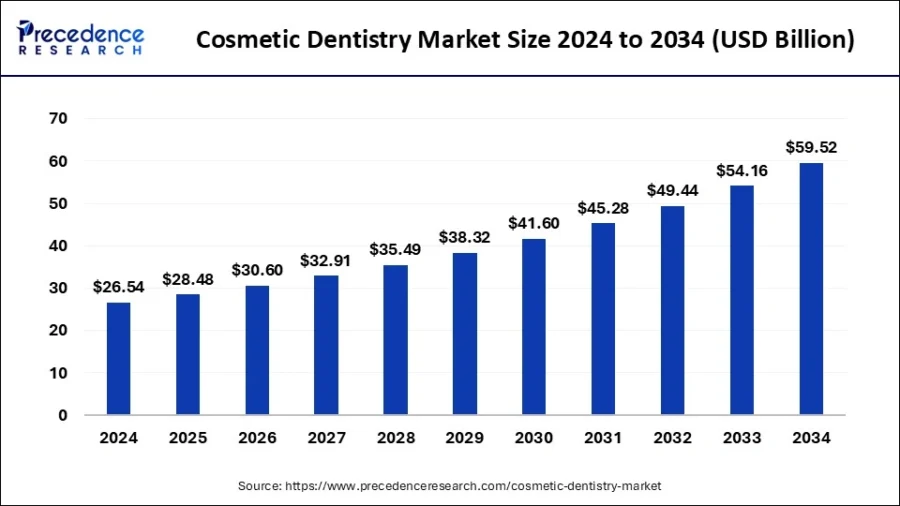
Source: Precedence Research
One of the most popular cosmetic procedures is still teeth whitening. By 2032, the worldwide market for teeth-whitening products is anticipated to reach USD 12.77 billion, driven by at-home kits and in-clinic procedures. More recent formulations that use light-assisted systems and peroxide substitutes lessen sensitivity and enhance long-term outcomes.
Companies, like Philips Zoom and Beyond Polus, provide high-intensity LED-based bleaching treatments. They show effects in less than an hour and, hence, chairside teeth whitening devices are growing in popularity. Custom-fit applicators and desensitizing gels have made these systems safer and more comfortable.
Further, Lumineers and DURAthin provide ultra-thin ceramic shells that require little to no tooth reduction, veneers, and no-prep laminates. The end effect is a cosmetic makeover that is permanent and reversible while maintaining teeth integrity.
Digital smile design (DSD) is starting to become commonplace. Dentists now co-plan aesthetic cases with patients in real time using smile simulation software and facial scanning. It combines bite alignment, tooth proportions, and facial symmetry to create individualized treatment plans.
InTeeth manufactures Invisible Teeth Aligners
Swiss startup InTeeth makes invisible teeth aligners that combine orthodontic correction and cosmetic enhancement. Orthodontists create staged 3D simulations using high-resolution intraoral scans that map the ideal aesthetic alignment of teeth.
The company fabricates each aligner using medical-grade, BPA-free thermoplastics and precision trimming to ensure a discreet appearance, optimal comfort, and effective force distribution.
The aligners address functional malocclusions and visual concerns like crowding, spacing, and midline shifts. This makes them suitable for patients seeking cosmetic improvement without traditional braces.
Zenyum provides Teeth Whitening Products
Singaporean startup Zenyum provides ZenyumBright series teeth whitening products that combine peroxide-based gels, LED-activated mouthpieces, and enamel-safe ingredients.
The company’s whitening system utilizes a carbamide peroxide formula that breaks down into hydrogen peroxide. This releases oxygen ions that penetrate the enamel and dissolve stain compounds without damaging tooth structure.
Additionally, its LED mouthpiece emits blue light at a calibrated wavelength to accelerate the whitening process and enhance treatment efficacy. The kit includes a pre-treatment foam to prepare the enamel surface and a post-treatment serum to remineralize teeth and reduce sensitivity.
5. Dental Diagnostics
The cornerstone of preventative dentistry is early and precise detection. Diagnostic dentistry is moving from reactive identification to proactive prediction as practitioners look for early intervention tools and patients demand precision care.
The market for dental diagnostic and surgical equipment is projected to grow at a compound annual growth rate of 8.2% between 2021 and 2028.
Dental practices are also integrating AI in radiography to enhance diagnostics. With real-time annotations on X-rays, platforms like Overjet and Denti.AI provide FDA-approved solutions for physicians to detect anomalies like caries, bone loss, and more. By enhancing diagnostic precision and consistency, these technologies reduce human errors.
Cone beam computed tomography (CBCT) imaging devices such as Acteon’s X-Mind Prime 3D and Planmeca’s Viso G7 offer comprehensive 3D imaging for airway analysis, endodontics, and implant design. They are feasible even for mid-sized clinics due to their small footprints and reduced radiation dosages.
Salivary diagnostics is becoming more popular as a real-time, non-invasive method of disease detection outside of imaging. To enable earlier and more focused intervention, tests developed by pioneers, like Floe, examine oral fluids for biomarkers linked to periodontal disease, caries risk, and even systemic inflammation.
For improved oral cancer screening, several clinics are also implementing intraoral fluorescent tools, like the VELscope. By illuminating aberrant tissue alterations that are not apparent in white light, these instruments increase the likelihood of early discovery.
Perceptive makes a Handheld Intraoral Scanner
US-based startup Perceptive manufactures a handheld intraoral scanner. It captures high-resolution 3D images of the oral cavity to support digital diagnostics, treatment planning, and prosthetic workflows.
The device leverages structured light technology and real-time AI processing to generate precise digital impressions without the discomfort of traditional molds. It features a lightweight, ergonomic design with autoclavable tips and plug-and-play connectivity. This simplifies integration into existing clinical setups.
The scanner delivers highly accurate full-arch scans, while the software platform offers automated margin detection and occlusal mapping. The company also offers a cloud dashboard that allows clinicians to review, annotate, and share scan data with labs or specialists. This facilitates remote collaboration and faster turnaround times.
Pearl advances AI-driven X-Ray Analysis
US-based startup Pearl offers Second Opinion, an AI-driven X-ray analysis platform. It detects and quantifies dental conditions in real time to support clinical decision-making. The platform uses deep learning algorithms trained on millions of annotated radiographs to identify various pathologies, like caries, bone loss, periapical radiolucencies, and calculus.
The platform integrates directly into dental imaging workflows to overlay diagnostic insights on 2D x-rays with region-specific markers and clinical labels. It also supports FDA-cleared pathology detection across bitewing, periapical, and panoramic views to ensure consistency and diagnostic accuracy during routine examinations.

6. Sustainable Dentistry
In dentistry, sustainability is now a fundamental principle influencing clinical decisions, supply chains, and patient preferences. Dental practitioners are looking for methods to reduce waste, pollution, and material overuse as the healthcare industry is held more responsible for its environmental effects.
The change is noticeable at every stage of the value chain, from clinical procedures to product packaging. The market for sustainable dentistry toolkits was estimated to be worth USD 1.2 billion in 2024 and is expected to reach USD 2.8 billion by 2033, growing at a CAGR of 9.8% from 2026 to 2033.
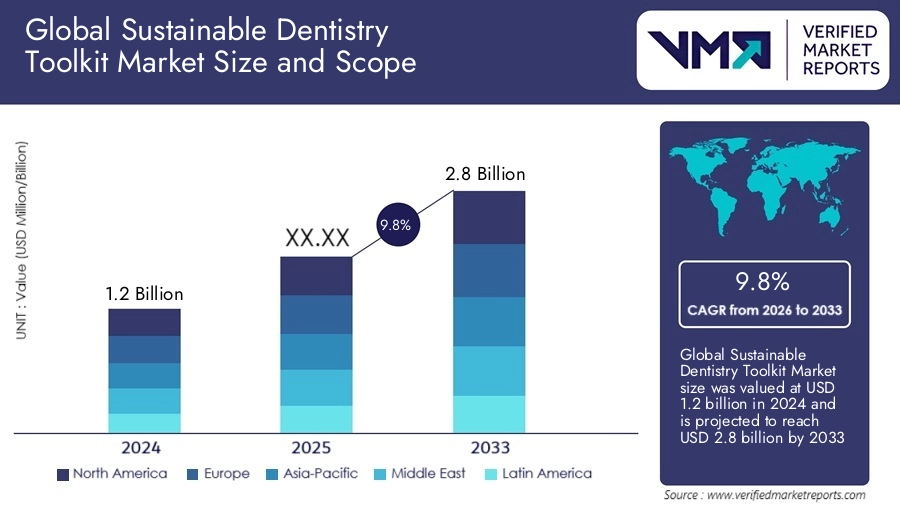
Source: Verified Market Reports
Moreover, a BMC Oral Health study found that patients are more inclined to select dental offices that align with their sustainability principles.
Eco-friendly dental care products are rapidly gaining popularity among consumers. Bamboo toothbrushes, reusable mouthwash tablets, and plastic-free floss are available from companies like Georganics and The Humble Co. To satisfy patient expectations and encourage more sustainable practices, dentists are promoting these products.
For example, the disposable tip of the micro-applicator used for bonding agents and sealants is one of the most common sources of plastic waste in dental clinics. Eco-friendly substitutes, like Premier Dental’s BioGreen biodegradable micro-applicators, and autoclavable handles with detachable tips are becoming more popular. They reduce the plastic that ends up in landfills without sacrificing precision or infection prevention.
Sustainability initiatives go far beyond single-use items. Compared to wet vacuum systems, dry vacuum systems save up to 360 gallons of water each day.
To reduce electricity use, clinics implement motion sensors and LED operatory lights. Waste from film processing and paper documentation is further decreased using digital imaging and paperless charting.
Zerolla provides Eco-Friendly Oral Care Products
UK-based startup Zerolla offers a line of eco-friendly oral care products to minimize environmental impact while maintaining effective hygiene standards. The company’s Zero Routine Set includes toothpaste tablets, a bamboo toothbrush, and silk dental floss housed in reusable and compostable packaging.
The toothpaste tablets contain fluoride and natural abrasives like calcium carbonate. They activate upon chewing and generate a cleansing foam without synthetic stabilizers or plastic tubes.
The toothbrush also features a biodegradable bamboo handle with castor oil-based bristles, while the floss uses mulberry silk coated in natural candelilla wax for gentle plaque removal. This way, Zerolla ensures alignment with clean label standards and oral microbiome compatibility.
DentPlanet offers Ecological Dental Micro-Applicator Tips
DentPlanet is a Belgian company that replaces conventional petroleum-based applicators with compostable alternatives. The ecological dental micro-applicator tips reduce single-use plastic waste in clinical dentistry without compromising application precision.
DentPlanet manufactures the tips from biodegradable materials like polylactic acid (PLA). This maintains structural integrity during use but decomposes under industrial composting conditions.
The applicators also feature a fine, bendable neck for accurate placement of bonding agents, etchants, and other fluids in minimally invasive procedures. They integrate smoothly into standard dispensers and maintain capillary control to ensure efficient material delivery without dripping or waste.
7. Oral Hygiene Products
From simple upkeep to a lifestyle-driven, scientifically supported category centered on prevention, customization, and long-term health, oral hygiene is changing. Patients are requesting treatments that address issues like enamel erosion, gum inflammation, and oral microbiota balance, in addition to cavity prevention.
By 2031, the oral care and hygiene market is expected to reach USD 1.46 billion, growing at a compound annual growth rate of 3.75%.
Leading this change are novel toothpastes and rinses. Companies like TANIT and Hello Products are developing fluoride-free, hydroxyapatite-based pastes that are safe for sensitive users and youngsters to remineralize enamel.
The antibacterial properties of pH-balancing mouthwashes and botanically infused rinses are also becoming more popular since they protect good bacteria.
Large companies are launching innovative product lines in response to consumer demand. Colgate-Palmolive introduced Colgate Elixir, a high-end product with a formulation intended to maintain the oral microbiome that comes in recyclable glass bottles.
Another example is Unilever’s Zendium. It is a natural enzyme-based toothpaste that increases good bacteria and lessens gum inflammation, and is especially well-liked in European markets.
With real-time coaching and feedback via smartphone apps, smart toothbrushes are becoming more and more popular.
Companies, like Boka and Oclean, place a strong emphasis on ergonomic design and acoustic vibration. With AI-powered brushing analysis for the best gum and plaque removal, Oral-B (by Procter & Gamble) is expanding its iO Series.
Gum health is also evolving into a niche market. Pastes and gels from companies like TheraBreath and Parodontax treat bleeding gums and inflammation, which are directly linked to the risk of diabetes and heart disease.
Innovations in pediatric care, like color-changing plaque disclosers, xylitol-based wipes, and chewable toothpaste tablets, are making dental hygiene fun and instructive for kids and parents.
Clean OS makes a Customizable Electric Toothbrush
Italian startup Clean OS develops a customizable electric toothbrush system that combines modular hardware and an AI-enabled operating platform to optimize oral hygiene. The system also tracks bristle degradation through usage patterns and recommends precise replacement intervals.
The system features a brush head attachment system based on neodymium magnets and a universal stem. This allows users to interchange soft, medium, and specialty bristles tailored for enamel sensitivity, orthodontic appliances, or gum care.
It delivers sonic vibrations at frequencies up to 31 000 strokes per minute using a high-efficiency linear magnetic drive. This ensures effective disruption of plaque biofilms without damaging soft tissue.
Neofunction offers an Oral Hygiene Device for Orthodontic Patients
Serbian startup Neofunction offers an oral hygiene device for orthodontic patients to improve cleaning efficiency around braces and fixed appliances. Its product, Neo-Pill, utilizes a mechanical vibration system and a specialized foam delivery capsule to dislodge food particles and reduce plaque buildup in hard-to-reach areas.
The device features a slim, ergonomic design that directs pulsating foam into inter-bracket spaces, gingival margins, and appliance contact points, where traditional brushes often fail. Further, it operates through a one-touch activation system and delivers a fixed-dose foam infused with fluoride and antibacterial agents.
This supports mechanical and chemical cleaning in a single step. The disposable capsules ensure hygiene and simplify use during active orthodontic treatment. Neofunction also provides digital usage tracking and refill scheduling via a companion app that monitors compliance.
8. Laser Dentistry
Laser dentistry is becoming a commonplace modality for restorative, surgical, and preventive operations; it is no longer limited to upscale clinics or specialized applications. Dental lasers are becoming more mainstream as patients seek out quicker, less intrusive, and painless treatment experiences.
The size of the global dental lasers market is projected to expand at a CAGR of 7.6% between 2023 and 2030. Growing use in soft-tissue surgery, periodontal therapy, cavity excision, and even endodontic sterilization is driving this growth.
Further, all-tissue lasers provide dual-wavelength platforms for hard and soft tissue applications. Major players like Biolase are at the forefront of this domain.
Biolase’s systems are renowned for decreasing intraoperative bleeding, speeding up postoperative recovery, and lowering the requirement for anesthesia. Similarly, Fotona’s LightWalker and SkyPulse laser systems are used for peri-implantitis decontamination, frenectomies, and more.
DEKA is another well-known brand in diode and erbium laser technology in Europe and Asia. Its SmartLite and SmartUS series are used for minimally invasive crown lengthening, depigmentation, and gingivoplasty.
To control chronic inflammation and promote healing in periodontal and implant situations, clinicians are employing lasers for low-level laser therapy (LLLT) and laser bacterial reduction (LBR). These methods present attractive alternatives in light of the growing antibiotic resistance and patient resistance to traditional surgery.
Further, lasers lessen the production of aerosols by eliminating the need for mechanical tools. This is a major issue during the COVID-19 pandemic that still affects infection control procedures today.
ImpLas NanoTech advances Laser-based Nano-Structuring
Canadian startup ImpLas NanoTech develops a laser-based nano-structuring technology. It enhances the surface properties of dental and orthopedic implants to improve integration with biological tissues.
The company leverages femtosecond laser pulses to create controlled nano- and micro-scale patterns on titanium and zirconia surfaces without chemicals or coatings. These surface modifications increase surface energy, promote protein adsorption, and stimulate cellular responses critical to osseointegration and soft tissue attachment.
Unlike conventional sandblasting or acid-etching, the laser process enables precise, reproducible structuring while preserving the material’s mechanical integrity. The technology also supports high-throughput surface customization and is compatible with existing implant geometries and manufacturing workflows.
Lunray Medical enables Laser-powered Dental Treatments
Chinese startup Lunray Medical offers LUNDENT, a laser-powered dental treatment platform. It delivers minimally invasive therapy for soft tissue surgery, periodontal care, and endodontic disinfection.
The platform uses a high-power 980 nm diode laser that generates coherent near-infrared light absorbed efficiently by hemoglobin and water. This enables precise ablation, coagulation, and bacterial reduction.
The platform’s thermal management system maintains a stable output during extended procedures. At the same time, the laser operates across adjustable power settings up to 10 watts with continuous wave and super-pulsed modes.
Further, the wireless handpiece integrates an optical fiber delivery system with autoclavable tips for focused energy transmission and optimal control over incision depth and thermal diffusion.
9. Teledentistry
Telehealth in dentistry improves efficiency, patient engagement, and access to treatment. Teledentistry is filling the gap between in-office care and virtual convenience as patients demand more flexibility, accessibility, and affordability. This is beneficial for preventive consultations, follow-ups, triage, and oral health education.
Further, increased use of digital health platforms by dental organizations and growing insurance reimbursement policies and smartphone prevalence are the main drivers of this rise.
The teledentistry industry is projected to increase at a CAGR of 16.2% to reach USD 7.6 billion by 2033.
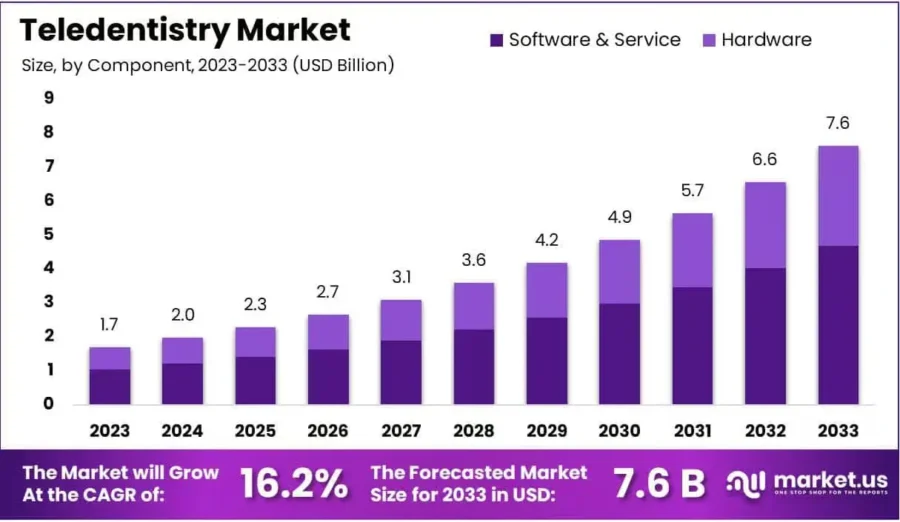
Source: Market.Us
Clinicians conduct remote assessments, patient monitoring, and inter-provider collaboration with teledentistry platforms like MouthWatch. Such platforms feature intraoral cameras and HIPAA-compliant software.
Similarly, Dentulu’s comprehensive ecosystem of mobile apps features AI-powered symptom screening, prescription delivery, and virtual consultations.
For example, SmileSnap offers asynchronous virtual consultation solutions for orthodontic offices and general practices. It allows patients to submit images and obtain evaluations without live video chats. This increases lead conversion, facilitates case pre-screening, and makes life easier for patients.
Major insurance companies and dental service providers also invest in virtual care solutions. To improve accessibility and convenience, Onsite Dental employs Teledentix to provide dental care to workers at organizations like Facebook, Boeing, and Salesforce.
Further, teledentistry addresses the gaps in rural care and public health settings. Dental hygienists and assistants are able to streamline care for underprivileged groups by gathering patient data in mobile or school-based clinics. They are also remotely sharing it with supervising dentists.
To decrease ER visits and enhance treatment continuity, Aspen Dental and Delta Dental have extended their teledentistry offerings by providing member portals and emergency consultations.
Toothfairy develops an AI-powered Teledentistry App
UK-based startup Toothfairy provides an AI-powered teledentistry app that connects patients with dentists for remote diagnosis, treatment planning, and follow-up care. The app allows users to upload photos and videos of their oral conditions. Its AI then flags potential issues and prioritizes clinical review.
Licensed dentists then validate the findings, offer tailored treatment recommendations, and prescribe medications directly through the app when necessary. The app also integrates electronic health records (EHRs), automated triage tools, and prescription services.
This enables complete digital case management without the need for in-person visits. Toothfairy also provides subscription-based care plans covering whitening, aligner therapy, and emergency support.
myDentist streamlines Online Dental Diagnosis & Consultation
Spanish startup myDentist offers an online dental diagnosis and consultation platform for virtual assessments, treatment advice, and care coordination. It enables patients to upload intraoral images, complete symptom checklists, and describe concerns through a guided interface.
Dentists then review the results to provide a diagnosis or care recommendation. The platform supports asynchronous consultations, prescription services, and referrals to partner clinics for follow-up treatment when necessary.
The system includes patient records management, image storage, and encrypted messaging to ensure clinical traceability and data security. Dentists access the platform’s practitioner dashboard to streamline case review, documentation, and communication.
10. 3D Printing
Traditional manufacturing workflows are under strain from rising material costs, limited lab capacity, lengthy turnaround times, and growing demand for individualized treatment. 3D printing enables quicker, more accurate, and more economical means to deliver surgical aids, aligners, and restorations.
The dental 3D printing market is expected to increase at a compound annual growth rate of 26.41% to reach USD 41.09 billion by 2034.
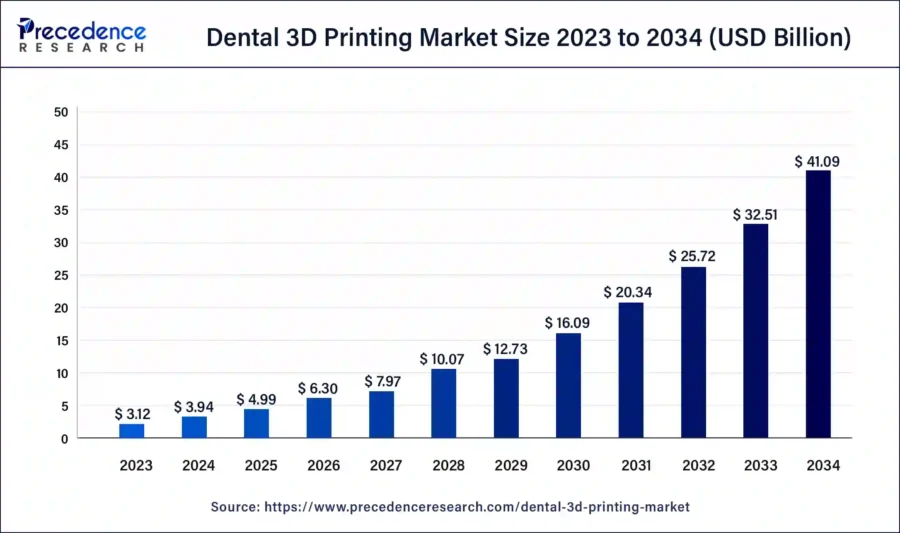
Source: Precedence Research
Dental-specific 3D printers, like Form 3B+, and a range of resins for use in dentures, surgical guides, splints, and bespoke trays are offered by market leader Formlabs. As a result, production periods are shortened from days to hours. This enables labs and clinics to produce intricate components on-site.
With the NextDent 5100, which combines quick printing rates with a range of CE-certified and FDA-cleared materials, 3D Systems enables dental labs to meet high-volume requirements. It is effective for dental service organizations (DSOs) and specialty labs that handle thousands of cases each month.
For regular dentists, SprintRay specializes in chairside 3D printing. It enables the same-day creation of surgical guides, night guards, and interim crowns. This improves therapeutic results and profitability by directly addressing inefficiencies like lab-related delays or patient no-shows.
To create smooth digital workflows, dentists are also combining 3D printing with intraoral scanners and CAD/CAM systems. These processes eliminate material waste, reduce manual errors, and save money for patients and providers.
Further, 3D printing has restorative and prosthodontic use cases with developments in biocompatible and flexible resins, antimicrobial materials, and multi-material printing.
Dentratec manufactures a Chairside Dental 3D Printer
Lebanese startup Dentratec makes a chairside dental 3D printer that enables clinics to produce crowns, bridges, surgical guides, and orthodontic models on demand. It utilizes LCD-based masked stereolithography (mSLA) technology to cure biocompatible resins layer by layer with high-resolution UV light exposure.
It achieves fine surface detail and dimensional accuracy. The printer features a compact footprint, touchscreen controls, and automated calibration for quick integration with clinical workflows.
The printer supports a range of dental resins for temporary and permanent restorations, as well as pairs with slicing software. This optimizes print orientation, support structures, and cure times. This way, the system reduces turnaround time for prosthetics and eliminates reliance on external labs.
2onelab provides a Dental Metal 3D Printer
German startup 2onelab develops a metal 3D printer that enables chairside or lab-based production of crowns, bridges, RPD frameworks, and custom abutments. It’s laser powder bed fusion (LPBF) technology utilizes a 200-watt fiber laser with a 30 μm spot size to selectively melt layers of cobalt-chrome or titanium alloy powders under a controlled argon atmosphere.
The printer achieves high-density outputs with isotropic mechanical strength and fine surface resolution. It also includes an inert gas filtration system, closed-loop powder recycling, and an integrated monitoring unit for real-time laser performance, layer uniformity, and thermal distortion tracking.
Discover all Dental Industry Trends, Technologies & Startups
To improve dental care access and streamline operations, practitioners will embrace DSOs and practice consolidation. The accuracy and effectiveness of all treatments will be improved by innovations like in-house dental milling and airway-focused dentistry.
At the same time, dental treatments will become more predictable and preventive with subscription-based care models, which will enhance patient engagement. The future of dental care delivery, patient experience, and company sustainability will be shaped by these new developments as healthcare demands change.
The Dental Trends & Startups outlined in this report only scratch the surface of trends that we identified during our data-driven innovation & startup scouting process. Identifying new opportunities & emerging technologies to implement into your business goes a long way in gaining a competitive advantage.
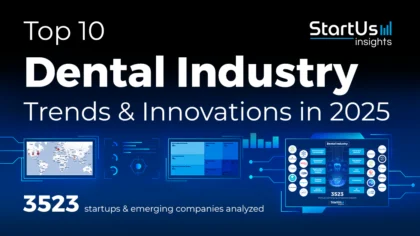


![Discover the Top 10 Trends in Precision Medicine [2025]](https://www.startus-insights.com/wp-content/uploads/2025/05/Precision-Medicine-Trend-SharedImg-StartUs-Insights-noresize-420x236.webp)
![Discover the Top 10 AI Trends in Healthcare [2025]](https://www.startus-insights.com/wp-content/uploads/2025/04/AI-Trends-in-Healthcare-SharedImg-StartUs-Insights-noresize-420x236.webp)
![AI in Healthcare: A Strategic Guide for Industry Leaders [2025-2030]](https://www.startus-insights.com/wp-content/uploads/2025/03/AI-in-Healthcare-SharedImg-StartUs-Insights-noresize-420x236.webp)




